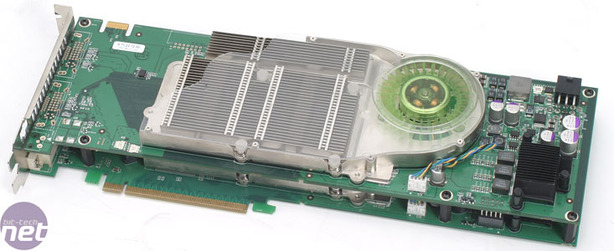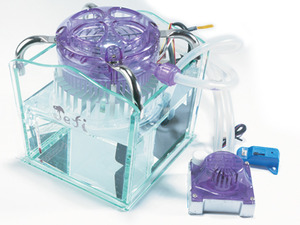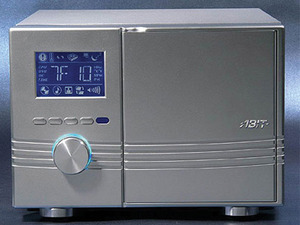
Hut of FAIL
For every action, there’s always an equal and opposite reaction. Behind our pantheon of the great and good stands a decrepit shack holding some of the worst pieces of technology we’ve ever seen. While the British are often uncomfortable with being the best, we’re happy to take pleasure in pointing out something that’s rubbish. More than happy really; from The Office to the Spanish Inquisition sketch, some of the UK’s greatest comedy is based on gentle and not so gentle jokes at the expense of ineptitude.All of which is to say that we couldn’t build our own virtual Hall of Fame without also constructing a hall of horrors, or in modern geek terms: a Hut of Fail. We’re going to immortalise products that go beyond being badly designed and flawed in conception to reach a special summit of terribleness.
Global Win Jefi
Launched Autumn 2004Inducted for Bringing water cooling and fish together
Water cooling is rather like Linux - it’s a technology beloved of enthusiasts, and perennially seems set for the mainstream. And like Linux, any sudden, rapid rise in its popularity is always thwarted, although we doubt that any Linux distro has been killed by literal thinking. Ubuntu 7.10 might be called ‘Gutsy Gibbon’ but no one seriously thinks this means that an overconfident ape should come swinging out of the screen when you load up the Live CD – so just because water cooling involves water doesn’t mean that fish should be involved.
Global Win’s Jefi made exactly this mistake, seeking to combine an all-in-one water-cooling kit with a fish tank (it was never reviewed by bit-tech, but we have an archive copy of the CPC review from 2004). The fish weren’t the only issue. The ‘aquarium container’ (the company’s own words), more commonly known as the reservoir, was completely open, with a radiator and fan assembly suspended above it, and the radiator dipping into the water. Water was pumped into the block and directed back to this assembly, then cooled by an 80mm fan as it dripped over the radiator and into the tank. The problem is that this means water evaporates, and it evaporates all the quicker the more efficient the cooler is.
During our testing, the Jefi required refilling once every ten hours. If you forgot to do this, it would run dry, your PC would overheat, and of course, any fish you’d been crazy enough to put in there would die. Global Win might not have been entirely serious about the fish, but it made a seriously terrible water-cooling kit.
Abit Digi Dice
Launched Winter 2003Inducted for Featuring the strangest add-on we’ve ever seen
The specs of the Abit Digi Dice, a me-too Pentium 4 small form factor bare bones, look reasonably sane in the word-crammed way PC manufacturers describe their products: "A TN LCD display for H/W monitor information, system status and Clock (System off)’ and ‘four user-friendly Hot-key functions for one-step enable Video, Music, Photo browser and CD copy application" sound like exactly the kind of features you’d expect.
It’s the last one on the list that you want to worry about: "Thermal energy recycle design for essential oil diffusion".
Yes, that’s right, not only did the Digi Dice seek to cash in on Shuttle’s small form-factor success, it also wanted a piece of The Body Shop’s aromatherapy market. It included a small bottle of ‘essential’ scented oil, and a tank that clipped onto the rear radiator in which to burn it. When the CPU heated it, the oil became warmed and evaporated into the room.
We’re all for manufacturers trying to differentiate their products with new ideas, but not every late-night, back-of-a-serviette idea should be seen through to completion.
GeForce 7900 GX2 in Quad SLI
Launched Summer 2006Inducted for Shaming Nvidia and partners into killing it within months
While we initially welcomed SLI, thanks to excellent launch motherboards such as the Asus A8N-SLI Deluxe and decent performance, within a year or so it was clear that SLI was lacking in resources and not delivering the speed you’d expect from multiple GPUs. At the time, Nvidia saw SLI as a huge part of its strategy and decided to launch Quad SLI, producing its first dual GPU graphics cards to help. The GeForce 7900 GX2s were 31cm long and used the now familiar dual-PCB sandwich design with holes cut in the PCB to allow for ventilation.

Quad SLI bombed when first launched
Quad SLI was only available to buy either as a complete PC from certain selected partners, or as an Nvidia-certified bare bones system.
Needless to say, this didn’t endear Quad SLI to enthusiasts – until they saw what they were missing. In his review for bit-tech, Tim said that "Quad SLI is a technology that simply isn't ready for the prime time", concluding that "There are far too many major bugs in Quad SLI and it needs of lot more work in NVIDIA's labs before it is anything like ready for public use. We just hope that system builders hold on to systems before shipping them out in the current state, as there are likely to be a lot of very disappointed customers."
In Custom PC, James was equally furious: "I expected to come away from four days of testing having found that Quad SLI is stupidly fast, but also stupidly expensive and noisy. However, in reality, Quad SLI is a hit-and-miss product. Even in games with specific Quad SLI profiles, it’s barely any faster, and sometimes slower, than 7900 GTX SLI, and in games with no Quad SLI profile, it’s noticeably slower than even a single 7900 GTX. You’d have to have more money than sense to buy Quad SLI now."
Not surprisingly, very few – a whisper said "literally a handful" – of the cards actually sold, and Nvidia, urged on by its partners, quietly disposed of the GeForce 7900 GX2. Just three months later, the company launched the dual-GPU GeForce 7950 GX2, pretending that the original had never existed.

MSI MPG Velox 100R Chassis Review
October 14 2021 | 15:04










Want to comment? Please log in.